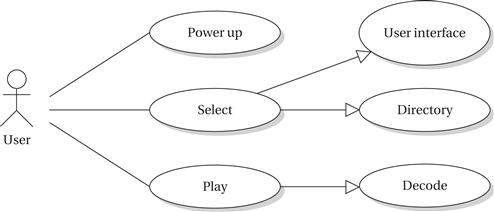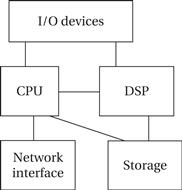4.6 Consumer Electronics Architecture
In this section we consider consumer electronics devices as an example of complex embedded systems and the platforms that support them.
4.6.1 Consumer Electronics use Cases and Requirements
Although some predict the complete convergence of all consumer electronic functions into a single device, much as has happened to the personal computer, we still have a variety of devices with different functions. However, consumer electronics devices have converged over the past decade around a set of common features that are supported by common architectural features. Not all devices have all features, depending on the way the device is to be used, but most devices select features from a common menu. Similarly, there is no single platform for consumer electronics devices, but the architectures in use are organized around some common themes.
This convergence is possible because these devices implement a few basic types of functions in various combinations: multimedia and communications. The style of multimedia or communications may vary, and different devices may use different formats, but this causes variations in hardware and software components within the basic architectural templates. In this section we will look at general features of consumer electronics devices; in the following sections we will study a few devices in more detail.
Functional requirements
Consumer electronics devices provide several types of services in different combinations:
• multimedia: The media may be audio, still images, or video (which includes both motion pictures and audio). These multimedia objects are generally stored in compressed form and must be uncompressed to be played (audio playback, video viewing, etc.). A large and growing number of standards have been developed for multimedia compression: MP3, Dolby DigitalTM, and so on for audio; JPEG for still images; MPEG-2, MPEG-4, H.264, and so on for video.
• data storage and management: Because people want to select what multimedia objects they save or play, data storage goes hand-in-hand with multimedia capture and display. Many devices provide PC-compatible file systems so that data can be shared more easily.
• communications: Communications may be relatively simple, such as a USB interface to a host computer. The communications link may also be more sophisticated, such as an Ethernet port or a cellular telephone link.
Nonfunctional requirements
Consumer electronics devices must meet several types of strict nonfunctional requirements as well. Many devices are battery-operated, which means that they must operate under strict energy budgets. A typical battery for a portable device provides only about 75 mW, which must support not only the processors and digital electronics but also the display, radio, and so on. Consumer electronics must also be very inexpensive. A typical primary processing chip must sell in the neighborhood of $10. These devices must also provide very high performance—sophisticated networking and multimedia compression require huge amounts of computation.
Use cases
Let’s consider some basic use cases of some basic operations. Figure 4.25 shows a use case for selecting and playing a multimedia object (an audio clip, a picture, etc.). Selecting an object makes use of both the user interface and the file system. Playing also makes use of the file system as well as the decoding subsystem and I/O subsystem.

Figure 4.25 Use case for playing multimedia.
Figure 4.26 shows a use case for connecting to a client. The connection may be either over a local connection like USB or over the Internet. While some operations may be performed locally on the client device, most of the work is done on the host system while the connection is established.

Figure 4.26 Use case of synchronizing with a host system.
Hardware architectures
Figure 4.27 shows a functional block diagram of a typical device. The storage system provides bulk, permanent storage. The network interface may provide a simple USB connection or a full-blown Internet connection.

Figure 4.27 Hardware architecture of a generic consumer electronics device.
Multiprocessor architectures are common in many consumer multimedia devices. Figure 4.27 shows a two-processor architecture; if more computation is required, more DSPs and CPUs may be added. The RISC CPU runs the operating system, runs the user interface, maintains the file system, and so on. The DSP performs signal processing. The DSP may be programmable in some systems; in other cases, it may be one or more hardwired accelerators.
Operating systems
The operating system that runs on the CPU must maintain processes and the file system. Processes are necessary to provide concurrency—for example, the user wants to be able to push a button while the device is playing back audio. Depending on the complexity of the device, the operating system may not need to create tasks dynamically. If all tasks can be created using initialization code, the operating system can be made smaller and simpler.
4.6.2 File Systems
DOS file systems
DOS file allocation table (FAT) file systems refer to the file system developed by Microsoft for early versions of the DOS operating system [Mic00]. FAT can be implemented on flash storage devices as well as magnetic disks; wear-leveling algorithms for flash memory can be implemented without disturbing the basic operation of the file system. The aspects of the standards most relevant to camera operation are the format of directories and files on the storage medium. FAT can be implemented in a relatively small amount of code.
Flash memory
Many consumer electronics devices use flash memory for mass storage. Flash memory is a type of semiconductor memory that, unlike DRAM or SRAM, provides permanent storage. Values are stored in the flash memory cell as an electric charge using a specialized capacitor that can store the charge for years. The flash memory cell does not require an external power supply to maintain its value. Furthermore, the memory can be written electrically and, unlike previous generations of electrically-erasable semiconductor memory, can be written using standard power supply voltages and so does not need to be disconnected during programming.
Flash file systems
Flash memory has one important limitation that must be taken into account. Writing a flash memory cell causes mechanical stress that eventually wears out the cell. Today’s flash memories can reliably be written a million times but at some point will fail. While a million write cycles may sound like a lot, creating a single file may require many write operations, particularly to the part of the memory that stores the directory information.
A wear-leveling flash file system [Ban95] manages the use of flash memory locations to equalize wear while maintaining compatibility with existing file systems. A simple model of a standard file system has two layers: the bottom layer handles physical reads and writes on the storage device; the top layer provides a logical view of the file system A flash file system imposes an intermediate layer that allows the logical-to-physical mapping of files to be changed. This layer keeps track of how frequently different sections of the flash memory have been written and allocates data to equalize wear. It may also move the location of the directory structure while the file system is operating. Because the directory system receives the most wear, keeping it in one place may cause part of the memory to wear out before the rest, unnecessarily reducing the useful life of the memory device. Several flash file systems have been developed, such as Yet Another Flash Filing System (YAFFS) [Yaf11].
